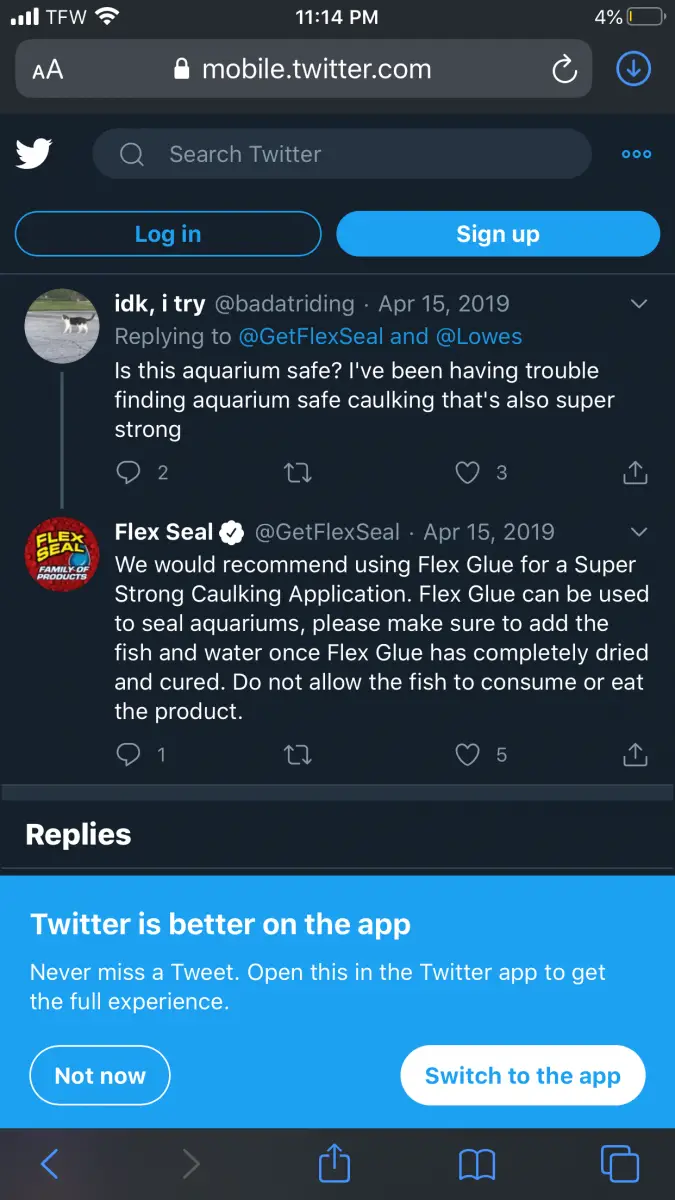If you’re an aquarium enthusiast, you’re probably always on the lookout for ways to make your tank more impressive. One popular product that has been making waves in the aquarium community is Flex Seal. However, you may be wondering, “is Flex Seal aquarium safe?” In this article, we will explore the safety of using Flex Seal in your aquarium and provide you with all the information you need to make an informed decision. So, if you’re ready to learn more about this product and its impact on your aquatic pets, keep reading!
Yes, Flex Seal is aquarium safe once fully cured. However, it is important to follow the curing instructions properly to ensure the safety of your aquatic pets. After applying Flex Seal, allow it to dry and cure for at least 48 hours before putting it in the tank. It is also recommended to rinse the sealed area thoroughly before adding any fish or plants to the aquarium.

Is Flex Seal Aquarium Safe?
If you’re an aquarium owner, you may have heard about Flex Seal. This product is known for creating a water-tight seal on a variety of surfaces, making it popular for home repairs. However, if you’re considering using Flex Seal in your aquarium, you may be wondering if it’s safe for your fish and other aquatic life. In this article, we’ll explore the safety of Flex Seal in aquariums and what you need to know before using it.
What is Flex Seal?
Flex Seal is a liquid rubber sealant that can be sprayed or brushed onto surfaces to create a waterproof barrier. It’s designed to seal leaks, cracks, and holes on a variety of surfaces, including metal, wood, plastic, and more. Flex Seal is known for its versatility and durability, making it a popular choice for home repairs.
Is Flex Seal Safe for Aquariums?
Flex Seal is not designed or marketed specifically for aquarium use, and the manufacturer does not recommend using it in aquariums. However, many aquarium owners have used Flex Seal in their tanks without issue. The main concern with using Flex Seal in aquariums is the potential release of harmful chemicals into the water.
The Risks of Using Flex Seal in Aquariums
Flex Seal contains solvents that can evaporate and release into the air. These solvents can be harmful to fish and other aquatic life, especially in high concentrations. Additionally, if the Flex Seal is not fully cured before being added to the aquarium, it may release uncured chemicals into the water, which can also be harmful to aquatic life.
Alternatives to Flex Seal for Aquarium Repairs
If you need to repair a leak or crack in your aquarium, there are several safe alternatives to Flex Seal that you can use. One option is aquarium-safe silicone sealant, which is designed specifically for use in aquariums. Another option is epoxy, which can be used to create a strong, waterproof bond.
The Benefits of Using Aquarium-Safe Sealants
Using aquarium-safe sealants has several benefits. First and foremost, they are designed specifically for use in aquariums, so you can be confident that they won’t harm your fish or other aquatic life. Additionally, these sealants are formulated to be waterproof and durable, so you can trust that they will hold up over time.
Flex Seal vs. Aquarium-Safe Sealants
When comparing Flex Seal to aquarium-safe sealants, it’s important to consider the risks and benefits of each. While Flex Seal may be a convenient option for home repairs, it’s not designed or recommended for aquarium use. Aquarium-safe sealants, on the other hand, are specifically formulated for use in aquariums and are designed to be safe for aquatic life.
How to Use Aquarium-Safe Sealants
If you decide to use an aquarium-safe sealant for your aquarium repairs, it’s important to follow the manufacturer’s instructions carefully. Make sure to thoroughly clean and dry the area you’ll be sealing, and apply the sealant in a well-ventilated area. Allow the sealant to fully cure before adding it to your aquarium.
In Summary
While Flex Seal may be a popular choice for home repairs, it’s not recommended for use in aquariums. The potential release of harmful chemicals into the water is a major concern, and there are several safe alternatives available. If you need to repair your aquarium, consider using an aquarium-safe sealant, which is designed specifically for use in aquariums and is safe for your fish and other aquatic life.
Frequently Asked Questions
Flex Seal is a popular brand of sealant that is used for various household and industrial applications. One of the most common questions people ask is whether Flex Seal is safe to use in aquariums. In this article, we will answer some of the most frequently asked questions about Flex Seal and its safety for aquariums.
Q: Is Flex Seal safe for aquariums?
Flex Seal is safe for aquariums when used properly. However, it is important to note that not all Flex Seal products are suitable for use in aquariums. Only the Flex Seal Liquid and Flex Seal Liquid Clear are safe for use in aquariums. Other products like Flex Seal Spray and Flex Seal Tape should not be used in aquariums as they may contain harmful chemicals.
Before using Flex Seal in your aquarium, it is important to read the label carefully and ensure that it is the right product for your needs. You should also follow the manufacturer’s instructions carefully to ensure that the product is applied correctly and safely.
Q: Is Flex Seal toxic to fish?
When used correctly, Flex Seal is not toxic to fish. However, if the product is not applied properly or is used on the wrong surfaces, it may release harmful chemicals into the aquarium water that can be toxic to fish. To prevent this, it is important to follow the manufacturer’s instructions carefully and ensure that the product is used only on surfaces that are safe for aquariums.
If you have any concerns about the safety of Flex Seal for your fish, you should consult with an expert or a professional aquarium service before using the product in your aquarium.
Q: How long does Flex Seal take to dry in an aquarium?
The drying time for Flex Seal in an aquarium depends on several factors, including the temperature, humidity, and thickness of the application. In general, Flex Seal takes about 24-48 hours to dry completely in an aquarium. However, it is important to note that the drying time may vary depending on the conditions in your aquarium.
To ensure that the product dries properly, you should follow the manufacturer’s instructions carefully and allow the product to dry completely before adding any fish or other aquatic creatures to the aquarium.
Q: Can Flex Seal be used to repair leaks in aquariums?
Flex Seal can be used to repair leaks in aquariums, but it is important to use the right product and apply it correctly. Only the Flex Seal Liquid and Flex Seal Liquid Clear are suitable for use in aquariums, and they should be applied in accordance with the manufacturer’s instructions.
If you are unsure about how to use Flex Seal to repair leaks in your aquarium, you should consult with an expert or a professional aquarium service to ensure that the repair is done correctly and safely.
Q: Is Flex Seal a permanent solution for aquarium repairs?
Flex Seal can provide a long-lasting and durable solution for aquarium repairs when used correctly. However, it is important to note that the product may not be a permanent solution in all cases. The durability of the repair will depend on several factors, including the type of damage, the surface that is being repaired, and the conditions in the aquarium.
To ensure the best possible results, it is important to follow the manufacturer’s instructions carefully and use the right product for your needs. If you have any concerns about the durability of the repair, you should consult with an expert or a professional aquarium service before using Flex Seal in your aquarium.

100% FLEX SEAL AQUARIUM?!? Will it work?
In conclusion, the question of whether or not Flex Seal is safe for aquariums is a controversial one. While the manufacturer claims that it is safe for use, there are mixed reviews from aquarium owners who have tried it.
It is important to note that using any product in an aquarium carries some degree of risk, and it is up to the individual to weigh the potential benefits against the potential risks. If you do decide to use Flex Seal in your aquarium, be sure to follow all instructions carefully and monitor your fish closely for any signs of distress.
Ultimately, the decision of whether or not to use Flex Seal in your aquarium is a personal one. If you are unsure or have concerns, it is always best to consult with a professional in the aquarium industry before making any changes to your tank.
